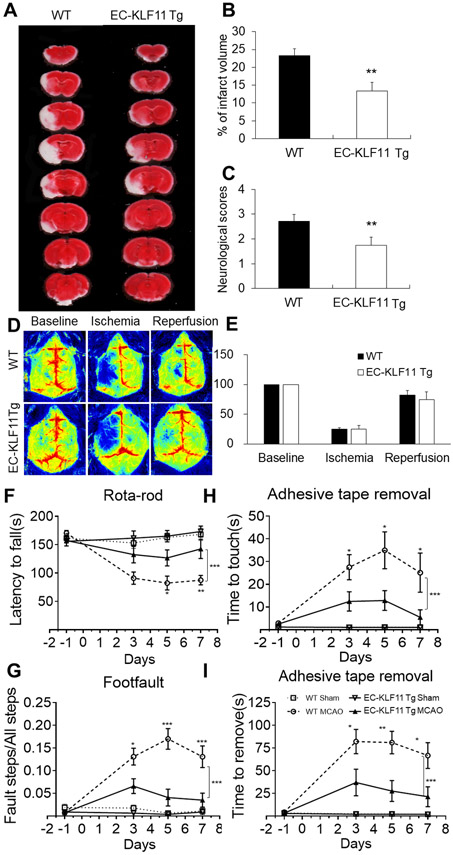Figure 3.
Transgenic overexpression of KLF11 in endothelium improves short-term histological and functional outcomes after focal cerebral ischemia. (A) EC-KLF11 Tg mice and WT controls were subjected to 1 h MCAO and 72 h reperfusion. Two percent TTC-stained coronal sections were shown at different brain levels from the frontal to the posterior pole. (B) Quantitative analysis was performed on infarct volume and (C) neurological deficits in these mice after ischemic stroke. n= 8 mice per group. (D) Regional CBF was measured by using a laser speckle imager. EC-KLF11 Tg and WT mice were subjected to 1 h MCAO followed by 72 h reperfusion. Representative CBF images were shown at 15 min before MCAO (baseline), 15 min after the onset of MCAO (ischemia), and 15 min after the onset of reperfusion (reperfusion). (E) Two identical elliptical ROIs were selected as indicated on the same brain region of the ipsilateral and contralateral hemispheres. The relative CBF was first determined as the ratio of ischemic to nonischemic cerebral blood flow, and then as the percentage value normalized to the presurgical baseline for each animal. n=6 each group. (F-I) Sensorimotor deficits were assessed before and up to 7 days after MCAO by a battery of behavioral tests, including Rotarod test (F), Foot fault (G), and Adhesive tape removal test (H-I). Compared with WT controls, mice with endothelial-specific overexpression of KLF11 showed dramatically improved sensorimotor function (increased staying latency in the rotarod test, lower rate of fault steps in the foot fault test, and shorter touching or removing time in the adhesive tape removal test. Data are represented as mean ± SD. n=12 per group. * p < 0.05, ** p < 0.01, *** p < 0.001 EC-KLF11 Tg MCAO vs. WT MCAO by one-way ANOVA (individual time point) or two-way ANOVA (bracket).

